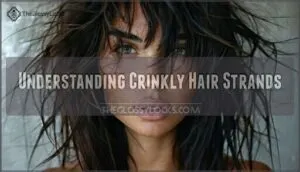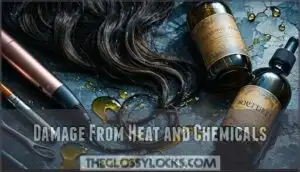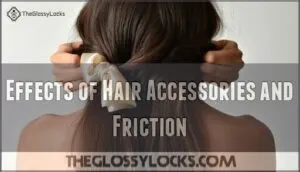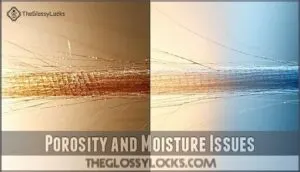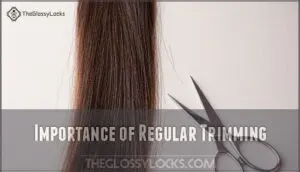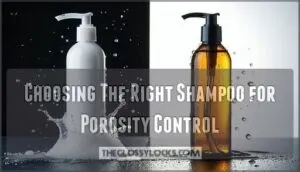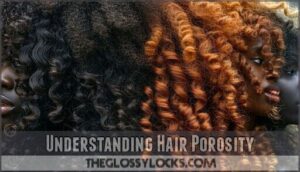This site is supported by our readers. We may earn a commission, at no cost to you, if you purchase through links.
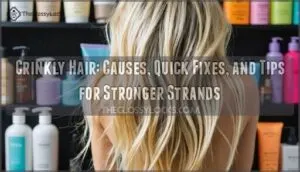
If your hair’s feeling more like a crumpled paper than silky waves, start with hydration—look for shampoos and conditioners packed with moisture and free of sulfates.
Damaged strands may also need some TLC, so reach for a protein-rich treatment or even natural options like henna to restore strength.
Avoid overusing heat tools and tightly styled accessories since they can make things worse, and don’t forget, regular trims help keep those pesky split ends in check to achieve smoother strands.
Want smoother strands? It’s all in the care!
Table Of Contents
- Key Takeaways
- Understanding Crinkly Hair Strands
- Causes of Crinkly Strands
- Managing Crinkly Hair
- Preventing Crinkly Strands
- Understanding Hair Porosity
- Frequently Asked Questions (FAQs)
- What does crinkly hair mean?
- How do you fix crinkly hair?
- What is the crinkly hair syndrome?
- What causes kinked hair?
- How do seasonal changes affect crinkly hair?
- Can stress contribute to hair crinkliness over time?
- Is crinkly hair more prone to tangles and knots?
- What role do hormonal changes play in hair texture?
- Are there specific tools to detangle crinkly strands effectively?
- Conclusion
Key Takeaways
- Focus on hydration by using deep conditioners, sulfate-free shampoos, and moisture-rich products to smooth out crinkly strands.
- Avoid heat tools and chemical treatments; replace them with protective styles and gentle hair care practices to prevent damage.
- Regular trims every 6-8 weeks help control split ends and maintain smooth, healthy hair.
- Identify your hair’s porosity level and choose tailored products, like lightweight conditioners for low porosity and protein masks for high porosity.
Understanding Crinkly Hair Strands
Crinkly hair can feel rough or bumpy, and it’s often a sign of damage or specific hair traits.
Crinkly hair reveals unique texture or hidden damage—nurture it with tailored care for vibrant, smooth, and healthy strands.
Understanding your hair’s structure, natural texture, and the effects of daily wear can help you manage and improve its condition.
Hair Strand Structure
Your hair strands are like tiny multi-layered shields.
The outermost layer, the hair cuticle, protects the inner layers—the cortex and, sometimes, the medulla.
When healthy, the cuticle cells lie flat, keeping your hair shiny and smooth.
Damage from styling tools, harsh chemicals, or environmental stressors lifts these scales, leading to hair porosity, dryness, and crinkly hair.
The cortex largely defines your hair texture and color, while cuticle integrity keeps damage at bay.
Care for these layers to maintain flexible, lively strands, ensuring cuticle integrity and a healthy hair texture!
Role of Genetics and Natural Texture
Your natural hair texture is shaped by the science of genetics.
It’s your unique genetic predisposition that determines whether your strands are straight, wavy, curly, or somewhere in between. Think of your natural curl pattern (or lack thereof) as your hair’s fingerprint—totally one of a kind!
- Follicle Shape: The shape of your hair follicles—round for straight hair, oval for curly—is genetically set. This directly affects texture variation and whether you notice crinkly hair.
- Growth Angle: How your hair grows out of the follicle (straight, at an angle, etc.) contributes to natural hair texture. Ethnic hair, in particular, shows these differences beautifully.
- Inherited Traits: Your family tree might explain your hair type quirks, including unexpected crinkles.
While products can enhance or protect, your genetics call the shots!
Impact of Environmental Factors
Living under harsh UV rays or battling air pollution can leave your hair feeling frazzled.
Weather effects like humidity cause frizzy hair, while seasonal changes mess with your hair texture.
Hard water? That’s another culprit!
To reduce environmental damage, shield strands with a UV spray, clarify buildup regularly, and use sulfate-free products for stable, healthy hair care.
Cold weather can also lead to winter hair problems, causing winter hair problems.
Causes of Crinkly Strands
Crinkly strands often show up when your hair faces too much heat, chemicals, or friction from styling. These factors weaken the cuticle, leaving your hair looking dry, rough, and uneven.
Damage From Heat and Chemicals
Overusing flat irons or curling wands can scorch your strands, leaving them brittle and causing cuticle layer damage.
Flat irons and curling wands can scorch strands, leaving them brittle—protect your hair to maintain strength and shine.
Chemical treatments like dyes or relaxers? They wreck disulfide bonds, leading to protein loss and crinkly, thirsty hair.
High porosity becomes your hair’s nemesis—moisture slips out as fast as it gets in.
Preventative measures are key: apply heat protectants religiously, limit heat styling damage, and treat tired locks with protein masks.
Remember, split ends love to party, so trim regularly to halt hair breakage.
Effects of Hair Accessories and Friction
If you’re struggling with frizz or breakage, your accessories and habits might be the culprits.
Avoid tension-heavy hairstyles and protect your strands by following these tips:
- Use silk or satin hair ties and pillowcases to minimize hair friction and reduce breakage.
- Ditch metal clips and tight elastics, opting for snag-free, gentle options instead.
- Prevent friction damage with protective styles, like loose braids or buns, ensuring your hair feels pampered, not strained.
To further combat frizz, consider how daily heat exposure can damage hair.
Porosity and Moisture Issues
After rough handling or harsh accessories, you might notice your hair feels dry and straw-like. That’s often tied to hair porosity—the way your strands absorb and retain moisture.
High porosity hair struggles with moisture retention, while low porosity resists product absorption.
To better care for your strands, try this:
| Porosity Level | Traits | Expert Tip |
|---|---|---|
| Low Porosity | Water beads up | Use heat when deep conditioning. |
| Medium Porosity | Balanced hydration | Protein treatments work wonders. |
| High Porosity | Quick moisture loss | Stick to porosity control shampoos. |
Not sure about your level? A simple hair porosity test—dropping hair in water—reveals how it acts. Remember, hydration methods suited to porosity lead to healthier, smoother hair, and using the right techniques can make a big difference in moisture retention and overall hair health.
Managing Crinkly Hair
You can manage crinkly hair by keeping up with regular trims and using products that restore moisture and strength.
Look for shampoos designed for porosity control and try protein or henna treatments to smooth and support your strands.
Importance of Regular Trimming
Snipping away split ends might seem small, but it makes a big difference in your hair care routine.
Regular trims—about every 6-8 weeks—are your secret weapon for Hair Health Maintenance, especially for curly hair or those battling uneven hair texture.
Split End Prevention is essential because split ends don’t just stay at the tips; they climb up, making hair look dull and crinkly.
Trimming Frequency also helps keep your Shape and Style fresh, giving your hair that polished, healthy vibe.
A clean cut means less tangling, smoother strands, and an easier time managing your overall hair routine.
If you’re thinking of DIY trims, use sharp scissors designed specifically for hair—regular ones can do more harm than good!
Remember, professional stylists aren’t just for fancy occasions; they’re key to getting the right trim for your growth goals.
A little maintenance now saves a lot of damage later.
Benefits of Protein and Henna Treatments
For crinkly strands, protein treatments and henna can work wonders.
Protein treatments are like a workout for your hair—they strengthen weak strands, repair damage, and improve elasticity, making it less likely to break.
If your hair needs a pick-me-up, these treatments enhance shine and lock in moisture, giving your crinkly strands a healthier, smoother look.
While protein treatments focus on intense hair repair, henna doubles as a conditioner and a natural dye.
Henna, on the other hand, offers natural advantages.
It adds strength by forming a protective layer around your hair, promotes scalp health, and even gives a glossy boost to dull strands.
Plus, it’s great for tackling dandruff and keeping premature grays at bay.
Just remember, henna can be drying, so pair it with moisturizing treatments for the perfect balance.
Hydrolyzed proteins fill gaps in the hair cuticle to repair damage.
Use treatments sparingly for lasting results to ensure your hair remains healthy and strong.
Choosing The Right Shampoo for Porosity Control
If protein treatments helped strengthen your strands, pairing them with the right shampoo will keep things smooth.
Choose sulfate alternatives and clarifying shampoos for better hair moisture retention. Many people are now switching to shampoos without sulfates for gentler cleansing.
Low porosity hair benefits from lightweight ingredients like panthenol, while high porosity thrives with moisturizing oils.
Understanding hair porosity guarantees hair care products work with your cuticles—not against them—boosting liveliness.
Preventing Crinkly Strands
If you want to keep crinkly strands at bay, focus on protecting your hair from heat and harsh chemicals.
Stick to gentle care, like using protective hairstyles and keeping your hair hydrated with the right products.
Avoiding Heat and Chemical Treatments
Why rely on damaging tools when heatless styling works wonders? Chemical treatments and heat damage can turn smooth strands into crinkly hair nightmares.
Instead, try natural dyes or chemical alternatives to maintain vibrancy without harm. Use protective products like leave-in conditioners and heat protectants, even for outdoor activities, to shield hair from damage.
Limit treatment frequency, focusing on nourishing routines instead. Embrace styles that celebrate your hair’s natural beauty—think twist-outs or air-dried waves.
By skipping harsh treatments and prioritizing hair protection, you’ll keep your strands healthier, shinier, and free from those pesky crinkles.
Protective Hairstyles to Reduce Damage
Keeping your hair happy doesn’t have to be a full-time job.
Protective hairstyles, like braids, twists, or buns, are your secret weapon for textured hair.
These “low-manipulation styles” help reduce daily handling, which means less damage and fewer crinkly strands trying to rebel.
Think of it like giving your hair a cozy retreat—it stays tucked in and avoids unnecessary wear and tear.
At night, wrap it up!
Use a satin or silk scarf or a bonnet for nighttime protection.
This shields your style as well as locks in moisture retention and promotes scalp health.
For a variety of options, consider exploring different types of hair coverings.
Want to go the extra mile?
Swap your pillowcase for a satin one to keep friction from messing with your style longevity.
Remember, these protective styles aren’t just a fashion statement—they’re about hair care, too.
Less damage, better growth, and healthier hair—it’s a win-win!
Keep it simple, keep it safe.
Maintaining Hair Health With Proper Care
Boosting your hair health doesn’t have to feel like rocket science.
Focus on these essentials:
- Hydration Techniques: Deep condition weekly to keep strands silky and strong.
- Gentle Detangling: Use a wide-tooth comb while hair’s wet, preventing breakage.
- Nighttime Protection: Sleep on satin pillowcases to reduce friction.
- Scalp Health & Diet Impact: Eat nutrient-packed meals for luscious locks and vibrant scalp health.
Understanding Hair Porosity
Your hair’s ability to absorb and retain moisture, known as porosity, plays a big role in its health and appearance.
Understanding how it works can help you choose the right products and routines to keep crinkly strands under control.
Conducting Porosity Tests
Decoding your hair’s porosity can feel like deciphering a secret code for better care.
A simple DIY porosity test can shed light on product absorption rates and how to tweak your routine. Try the float test—drop a clean strand in water:
| Porosity Test Types | What to Look For | Interpreting Test Results | Treatment Impact |
|---|---|---|---|
| Float Test | Hair floats or sinks | Float = Low, Sink = High | Adjust moisture products |
| Slide Test | Smooth or bumpy texture | Smooth = Low, Bumpy = High | Add moisture or protein care |
Understanding hair porosity levels is key to choosing the right products. Tailor care to fit, and for more information, visit hair porosity levels.
Factors Increasing Porosity
Porosity plays a big role in your hair’s texture and hydration, but certain habits can make things worse.
If you’ve noticed more hair damage or dryness, here’s what to watch out for:
- Chemical Overload: Frequent dye jobs, relaxers, or perms can weaken the cuticle, leaving hair more porous.
- Environmental Exposure: Sun, pollution, and even hard water can strip your hair’s moisture and cause damage.
- Excessive Heat Application: Blow drying and flat irons can burn the cuticle, leading to improper hydration.
Healthy hair loves balance, so avoiding these pitfalls can help maintain smoother strands and steady hydration levels.
Adjusting Hair Care for Porosity Levels
Understanding your hair’s porosity level can open the door to better scalp health and stronger strands.
- Pinpoint Porosity: Use the float or slide test to identify low, normal, or high porosity.
- Porosity Treatments: High porosity thrives on protein treatments and deep conditioning, while low porosity loves lightweight hair products.
- Hydration Overhaul: Adjust washing habits—moisture retention is key for high porosity, while clarifying shampoos help low porosity.
- Product Absorption Tricks: High porosity needs protection from over-styling, but low porosity benefits from warm water to aid absorption.
Understanding porosity helps tailor optimal moisture management for your hair.
Frequently Asked Questions (FAQs)
What does crinkly hair mean?
When life gives you lemons, crinkly hair might follow—it’s hair that feels bumpy, dry, or uneven.
It’s often damaged from heat, chemicals, or harsh handling.
Deep conditioning and gentle care can smooth things out.
How do you fix crinkly hair?
Fix crinkly hair by moisturizing with deep conditioners, cutting split ends, and avoiding heat tools.
Use sulfate-free shampoo, a satin pillowcase, and gentle detangling techniques.
Protein treatments strengthen strands, while oils like argan add smoothness, and using these methods can help to fix crinkly hair by moisturizing.
What is the crinkly hair syndrome?
Crinkly hair syndrome refers to irregular, bumpy hair strands caused by damage, genetics, or health issues.
It’s like your hair gets stubborn and crinkly; treating it needs gentle care, hydration, and avoiding harsh styling practices to improve its condition and overall health, making gentle care essential.
What causes kinked hair?
Kinked hair happens due to dryness, split ends, heat damage, or over-styling.
Not trimming enough or using harsh chemicals can worsen it.
Protect it with conditioning, gentle handling, and avoiding tight hairstyles to keep strands smooth.
How do seasonal changes affect crinkly hair?
Imagine a humid summer day—your hair frizzes instantly.
Seasonal changes like humidity make hair drier or frizzier.
Use moisture-rich conditioners, anti-humidity sprays, or oils to keep strands smooth and protect against environmental stress.
Can stress contribute to hair crinkliness over time?
Yes, stress can mess with your hair over time.
It disrupts your hormones, weakens strands, and triggers habits like rough styling.
Stay chill, nourish your hair, and show it some TLC—it’ll thank you!
Is crinkly hair more prone to tangles and knots?
You know that feeling when a necklace tangles? Hair’s the same!
Bumpy textures grab onto each other, making knots more likely.
To prevent this, use detanglers, conditioners, and wide-tooth combs—it’s smoother sailing!
What role do hormonal changes play in hair texture?
Hormonal changes can alter hair texture by affecting oil production, growth cycles, and strand structure.
For smoother hair during shifts, try moisturizing products, gentle styling, and regular trims.
Stay hydrated, and boost your diet with proteins!
Are there specific tools to detangle crinkly strands effectively?
Use a wide-tooth comb or a detangling brush specially designed for textured hair.
Start from the ends, working upwards gently, adding leave-in conditioner or detangling spray makes the process smoother, reducing breakage and frustration.
Conclusion
Think of crinkly hair as your hair’s way of asking for extra care.
By focusing on hydration, using sulfate-free shampoos, and incorporating protein or henna treatments, you can restore strength and smoothness.
Regular trims and avoiding harsh heat tools or tight styles also make a big difference.
Test your hair’s porosity to tailor your routine for best results.
With the right care and a little patience, you’ll soon say goodbye to crinkles and hello to healthier strands!

